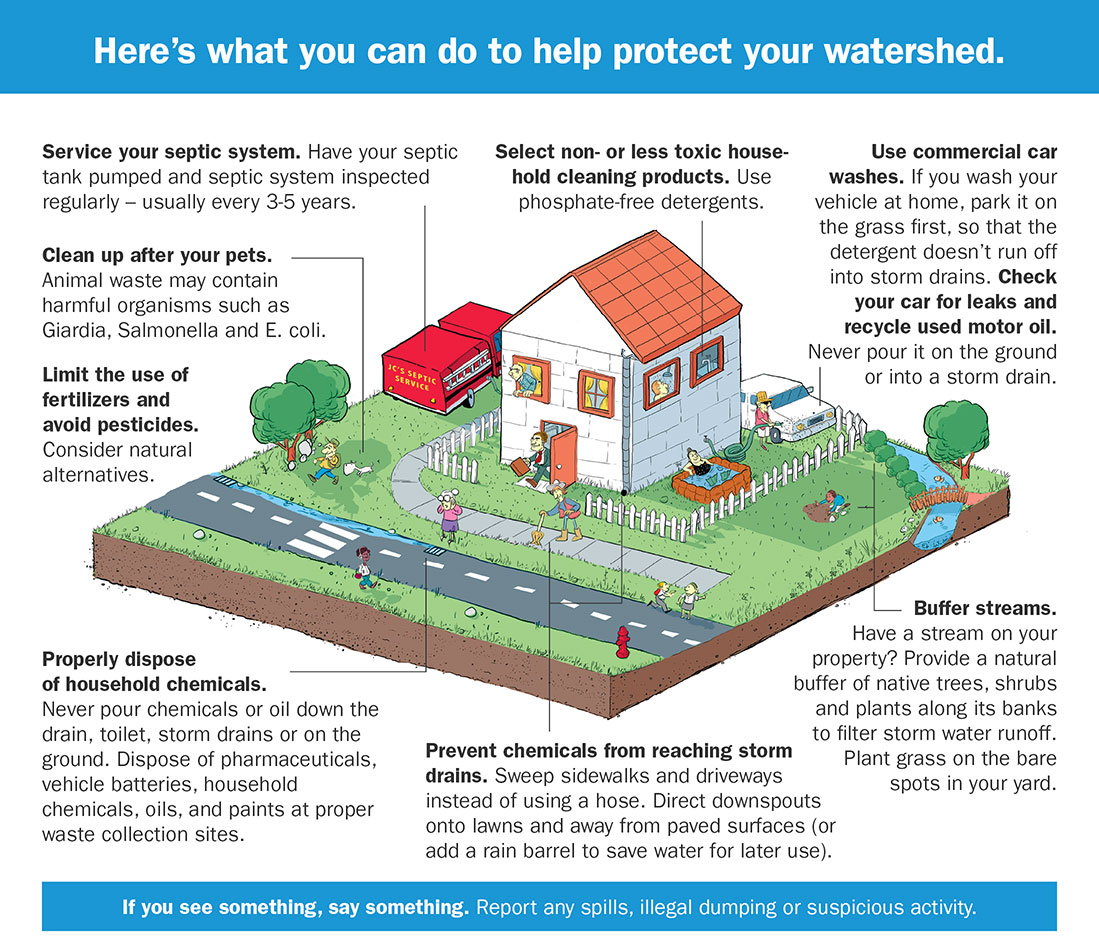WATERSHED PROTECTION
We all live in a watershed. Watersheds are areas of land where runoff from rain and snow drains into a lake, stream, river or wetland. Water constantly travels over the land’s surfaces that include farmland, lawns and city streets, on its course to a waterway. When it rains, water runs over the surface picking up any pollutants that are on the way. Small amounts of motor oil, pet waste, pesticides or litter are multiplied along the journey to the nearest waterway.

Watersheds are areas of land that drain into a lake, river or stream. As water travels over the land’s surface through farms, fields, forests, lawns and city streets; it’s impacted by what happens in the watershed. In New Jersey, many waterways serve as sources of community drinking water supplies, so it’s important that we all take steps to protect and improve this precious natural resource. Your yard is part of a watershed.
These watersheds are full of life. They provide habitat for fish, birds and wildlife. They are also a source of drinking water for homes and businesses. No matter where you live, work or play, you are always in a watershed.
What we all do to the land makes a difference in the quality of water in our rivers and streams. Because of this, and because our work brings us into daily contact with local water resources and watersheds, we spend a lot of our time and efforts protecting our water resources.
Locally, we work every day to help protect our natural resources.
Ten Simple Steps to Protect Your Watershed
The right decisions can help protect these important water resources. Here are a few ways you can help preserve the source of our drinking water and our wildlife habitat.
- Plan the landscaping around your home or business with more permeable surfaces that allow water to soak into the ground. Try to limit concrete and asphalt, as they contribute to increased levels of storm water runoff. Help prevent soil erosion by preserving existing trees and planting new trees and shrubs.
- Use native plants that require minimal fertilizer, herbicides and watering. Do not over-apply chemicals and avoid application immediately before it rains.
- Keep litter, pet waste and yard waste out of streets and storm drains. Pet waste contains bacteria that can find its way into waterways through runoff.
- Select non-toxic or less toxic alternatives to typical household products, such as cleaning agents.
- Use pharmaceutical disposal programs offered by local police departments or other agencies that can help you dispose of unneeded medicines safely.
- Find an opportunity for a rain garden. Rain gardens use native plants and grasses to capture and absorb rainwater from rooftops and roads. These planned gardens help simplify lawn maintenance, control erosion and reduce runoff into streams and storm water systems.
- Recycle! Visit the New Jersey Department of Environmental Protection Recycling Information site.
- Get involved in community activities to clean up waterways and monitor water quality.
- Use hazardous waste collection sites and services for disposal of household wastes such as chemicals, paints, motor oil and batteries. Be sure to check the list of approved items accepted by the collection agency.
- At work, consider membership in EPA’s Wastewise – a free, voluntary program through which organizations eliminate costly municipal solid waste and select industrial wastes, benefiting their bottom line and the environment.
Road Salt and Drinking Water
During the winter, road salt can provide an important safety benefit, but it can also negatively impact the environment. Excess salt can be carried to streams and storm drains or soak directly into the ground, and it can be harmful to aquatic life and drinking water supplies.
Click here to read our road salt factsheet and learn how you can reduce the environmental and drinking water impacts of road salt.